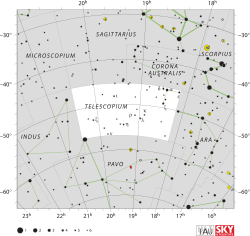Alpha Telescopii

| |
| Observation data Epoch J2000 Equinox J2000 | |
|---|---|
| Constellation | Telescopium |
| Right ascension | 18h 26m 58.41604s[1] |
| Declination | –45° 58′ 06.4498″[1] |
| Apparent magnitude (V) | 3.51[2] |
| Characteristics | |
| Spectral type | B3 IV[3] |
| U−B color index | −0.64[2] |
| B−V color index | −0.17[2] |
| Variable type | SPB[4] |
| Astrometry | |
| Radial velocity (Rv) | −0.2[5] km/s |
| Proper motion (μ) | RA: −16.95[1] mas/yr Dec.: −53.09[1] mas/yr |
| Parallax (π) | 11.74 ± 0.17[1] mas |
| Distance | 278 ± 4 ly (85 ± 1 pc) |
| Details | |
| Mass | 5.2 ± 0.4[4] M☉ |
| Radius | 3.3 ± 0.5[4] R☉ |
| Luminosity | 794[4] L☉ |
| Surface gravity (log g) | 4.12 ± 0.20[4] cgs |
| Temperature | 16,700 ± 800[4] K |
| Rotational velocity (v sin i) | 14 ± 8[4] km/s |
| Age | 24.1 ± 7.5[6] Myr |
| Other designations | |
Alpha Telescopii (α Tel, α Telescopii) is the brightest star in the constellation Telescopium, with an apparent visual magnitude of 3.5.[2] Ptolemy included it in constellation Corona Australis, but it was moved to Telescopium when that constellation was created by Nicolas Louis de Lacaille in the 18th century.[8] Parallax measurements put it at a distance of 278 light-years (85 parsecs) from Earth.
This star is much larger than the Sun, with an estimated 5.2±0.4 times the mass and 3.3±0.5 times the radius.[4] The spectrum of the star matches a stellar classification of B3 IV,[3] where the luminosity class of 'IV' indicates this is a subgiant star that has nearly exhausted the supply of hydrogen at its core and is evolving away from the main sequence. Alpha Telescopii is a bright star that is radiating nearly 800 times the Sun's luminosity. This energy is being emitted from the star's outer envelope at an effective temperature of around 16,700 K,[4] giving it the characteristic blue-white hue of a B-type star.[9]
This is possibly a type of variable star known as a slowly pulsating B-type star. It has a longitudinal magnetic field with a mean strength of –233 ± 43 G.[4] A projected stellar rotation velocity of about 14 km s−1 is considered low for a star of this type,[4] which may indicate it is being viewed from nearly pole-on.[10]
References
- 1 2 3 4 5 van Leeuwen, F. (November 2007), "Validation of the new Hipparcos reduction", Astronomy and Astrophysics, 474 (2): 653–664, arXiv:0708.1752
 , Bibcode:2007A&A...474..653V, doi:10.1051/0004-6361:20078357
, Bibcode:2007A&A...474..653V, doi:10.1051/0004-6361:20078357 - 1 2 3 4 Johnson, H. L.; et al. (1966). "UBVRIJKL photometry of the bright stars". Communications of the Lunar and Planetary Laboratory. 4 (99). Bibcode:1966CoLPL...4...99J.
- 1 2 Houk, Nancy (1978), Michigan catalogue of two-dimensional spectral types for the HD stars, 2, Ann Arbor: Dept. of Astronomy, University of Michigan, Bibcode:1975mcts.book.....H
- 1 2 3 4 5 6 7 8 9 10 11 Hubrig, S.; et al. (April 2009), "New magnetic field measurements of β Cephei stars and slowly pulsating B stars", Astronomische Nachrichten, 330 (4): 317, arXiv:0902.1314
 , Bibcode:2009AN....330..317H, doi:10.1002/asna.200811187
, Bibcode:2009AN....330..317H, doi:10.1002/asna.200811187 - ↑ Evans, D. S. (June 20–24, 1966), "The Revision of the General Catalogue of Radial Velocities", in Batten, Alan Henry; Heard, John Frederick, Determination of Radial Velocities and their Applications, Proceedings from IAU Symposium no. 30, University of Toronto: International Astronomical Union, Bibcode:1967IAUS...30...57E
- ↑ Tetzlaff, N.; Neuhäuser, R.; Hohle, M. M. (January 2011), "A catalogue of young runaway Hipparcos stars within 3 kpc from the Sun", Monthly Notices of the Royal Astronomical Society, 410 (1): 190–200, arXiv:1007.4883
 , Bibcode:2011MNRAS.410..190T, doi:10.1111/j.1365-2966.2010.17434.x
, Bibcode:2011MNRAS.410..190T, doi:10.1111/j.1365-2966.2010.17434.x - ↑ "alf Tel -- Star", SIMBAD, Centre de Données astronomiques de Strasbourg, retrieved 2012-01-15
- ↑ Ridpath, Ian, "Corona Austalis, the Southern Crown", Ian Ridpath's Star Tales, retrieved 2012-01-15
- ↑ "The Colour of Stars", Australia Telescope, Outreach and Education, Commonwealth Scientific and Industrial Research Organisation, December 21, 2004, retrieved 2012-01-16
- ↑ Kaler, James B., "ALPHA TEL (Alpha Telescopii)", Stars, University of Illinois, retrieved 2012-01-15